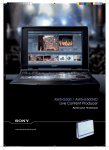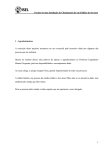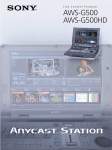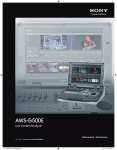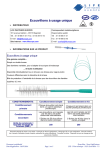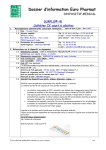Download PIPETMAN® P
Transcript
PIPETMAN P ® ENGLISH Other languages can be consulted and downloaded on our website, www.gilson.com. PIPETMAN® P CONTENTS page 1 - INTRODUCTION 2 2 - PARTS CHECK LIST 3 3 - DESCRIPTION 3 4 - OPERATING RANGES 4 5 - SETTING THE VOLUME 5 6 - PIPETTING 6 7 - GILSON DIAMOND TIPS ® 9 8 - PERSONALIZING YOUR PIPETTE 11 9 - GLP FEATURES 12 10 - TROUBLESHOOTING 13 11 - LEAK TEST 15 12 - MAINTENANCE 16 13 - CLEANING AND DECONTAMINATION 19 14 - SPECIFICATIONS 22 15 - SPARE PARTS 24 EC DECLARATION OF CONFORMITY 25 1 - INTRODUCTION Congratulations on acquiring your new Pipetman P. Enjoy the following features. - Continuously-adjustable, designed to dispense precise volumes of liquid safely. - Large range of volumes, eight models cover a range from 0.1 µL to 10 mL, for many applications: P2 and P10: measurement and transfer of micro-volumes, DNA sequencing and enzymeassays. P20, P100, P200, P1000: measurement and transfer of general aqueous solutions, acids and bases. 2 ENGLISH P5000, P10ml: measurement and transfer of large volumes. - Volume is continuously adjustable within the useful volume range using the digital volumeter. - Tip-ejector and disposable tips mean no need to handle tips, protecting the user from contamination. - Carry-over between samples eliminated by using a new tip from a Tipack™ box for each transfer. - Nominal volume (i.e. pipette model) is shown on the color coded push-button. - Personalize your Pipetman by fitting a Coloris™ identification clip to the connecting nut (5 colors). 2 - PARTS CHECK LIST Just take a moment to verify that the following items are present: - Pipetman P, User's Guide, Sample pack of tips, Safety bag, Adhesive id-tags (strip of 4), Certificate of conformity (including bar-code sticker). 3 - DESCRIPTION refer to the schematic on the next page ☞ toPlease see the items. A) Color coded push-button for setting the volume, aspirating, and dispensing. B) Body or handle. 3 PIPETMAN® P C) Connecting nut to upper par t (body or handle) of removable tipholder. A T D) Diamond tip. E) Tip-ejector. F) Tip-ejector button. H) Tip-holder (removable for cleaning and decontaminating). F V B C E T) Thumbwheel for setting the volume. H V) Volumeter. D 4 - OPERATING RANGES Model Range P2* P10* P20 P100 P200* P1000 P5000 P10ml 0.2 - 2 µL 1 - 10 µL 2 - 20 µL 20 - 100 µL 50 - 200 µL 200 - 1000 µL 1 - 5 mL 1 - 10 mL With a precise pipetting technique (see “Gen☞ * eral Guidelines for good pipetting”) P2 may be used to aspirate volumes down to 0.1 µL, P10 at 0.5 µL, and P200 at 30 µL. 4 ENGLISH 5 - SETTING THE VOLUME The volume of liquid to be aspirated is set using the volumeter. The volumeter consists of three number-dials, which are read from top (most significant digit) to bottom (least significant digit). A marker is used to set exact or intermediate volumes using the scale on the bottom dial. The dials are colored either black or red to indicate the position of the decimal point, according to the model (see examples). The volume is set by turning the thumbwheel or the pushbutton. The push-button makes it easier and quicker to set volumes, especially when wearing gloves. The thumb-wheel may be turned to slowly reach the required setting. Thumbwheel Push-button To obtain maximum accuracy when setting the volume, proceed as follows: - when decreasing the volume setting, slowly reach the required setting, making sure not to overshoot the mark. - when increasing the volume setting, pass the required value by 1/3 of a turn and then slowly decrease the volume to reach the volume, making sure not to overshoot the mark. Model P2 to P200 P1000, P5000 P10ml Color of volumeter numbers Black Red µL 0.1 µL and 0.01 µL 0.1 mL and 0.01 mL mL mL 0.1 mL 5 PIPETMAN® P Example for each pipette: P2 P10 P20 P100 1 2 5 0 7 5 1 2 5 0 7 5 1.25 µL 7.5 µL 12.5 µL 75 µL P5000 P10ml P200 P1000 1 2 5 0 7 5 125 µL 0.75 mL 1 2 5 1.25 mL 0 7 5 7.5 mL To avoid parallax errors, make sure that the volume indicator and the selected volume marking are in your direct line of vision. At close range you may find it helps to close one eye. 6 - PIPETTING 1) Fit a new Gilson Diamond Tip. Plastic tips are for a single application - they must not be cleaned for reuse. Push the tipholder into the tip using a slight twisting motion to ensure a firm and airtight seal. (1) For P2 and P10: tip ejector extensions are supplied. (2) P5000 and P10ml: insert a filter into the tip holder before fitting a tip. (If the filter gets dirty it should be replaced with a clean one.) (3) P5000 and P10ml: these models are not equipped with tip-ejectors. ☞ 6 ENGLISH 2) Pre-rinse the tip. Some liquids (e.g. protein-containing solutions and organic solvents) can leave a film of liquid on the inside the wall of the tip; pre-rinse the tip to minimize any errors that may be related to this phenomenon. Pre-rinsing consists of aspirating the first volume of liquid and then dispensing it back into the same vessel (or to waste). Subsequent volumes that you pipette will have levels of accuracy and precision within specifications. 3) Aspirate. Press the push-button to the first stop (this corresponds to the set volume of liquid). Hold the pipette vertically and immerse the tip in the liquid (see immersion depth table). Release the push-button slowly and smoothly (to top position) to aspirate the set volume of liquid. Wait one second (time depends on model, see table) ; then withdraw the pipette-tip from the liquid. You may wipe any droplets away from the outside of the tip using a medical wipe, however if you do so take care to avoid touching the tip’s orifice. 4) Dispense. Place the end of the tip against the inside wall of the recipient vessel (at an angle of 10° to 40°). Press the push-button slowly and smoothly to the first stop. Wait for at least a second; then press the push-button to the second stop to expel any residual liquid from the tip. Keep the push-button pressed fully down and (while removing the pipette) draw the tip along the inside surface of the vessel. Release the push-button, smoothly. 7 PIPETMAN® P 5) Eject the tip by pressing firmly on the tip- ejector button. Top 1st Stop 2nd Stop General Guidelines for Good Pipetting 1) Make sure that you operate the push-button slowly and smoothly. 2) When aspirating, keep the tip at a constant depth below the surface of the liquid (refer to the table). Table - Immersion Depth & Wait Time Model Immersion Depth (mm) Wait Time (Seconds) P2 P10 P20 P100 P200 P1000 P5000 P10ml 1 1 2-3 2-4 2-4 2-4 3-6 5-7 1 1 1 1 1 2-3 4-5 4-5 3) Change the tip before aspirating a different liquid, sample, or reagent. 4) Change the tip if a droplet remains at the end of the tip from the previous pipetting operation. 8 ENGLISH 5) Each new tip should be pre-rinsed with the liquid to be pipetted. 6) Liquid should never enter the tip-holder; to prevent this: - press and release the push-button slowly and smoothly, - never turn the pipette upside down, - never lay the pipette on its side when there is liquid in the tip. 7) If you use the same tip with a higher volume, pre-rinse the tip. 8) For volatile solvents you should saturate the air-cushion of your pipette by aspirating and dispensing the solvent repeatedly before aspirating the sample. 9) When pipetting liquids with temperatures different to the ambient temperature, pre-rinse the tip several times before use. 10) You may remove the tip-ejector (see “Maintenance”) to aspirate from very narrow tubes. 11) After pipetting acids or other corrosive liquids that emit vapors, remove the tip-holder and rinse the piston and O-ring and seal with distilled water. 12) Do not pipette liquids having temperatures above 70 °C or below 4 °C. The pipette can be used between + 4 °C and + 40 °C but the specifications may vary according to the temperature (see Chapter 14 for controlled conditions of use). 7 - GILSON DIAMOND TIPS Gilson Diamond Tips are made to the highest specifications, strict quality control is maintained throughout the manufacturing process. Diamond Tips are used to calibrate Pipetman P, 9 PIPETMAN® P therefore for optimum performance, you are strongly advised to use Gilson's Diamond Tips with your Pipetman P. Diamond Tips have the Gilson logo engraved on their collar, ensuring that you have a genuine Gilson product. To ensure accuracy and precision, Gilson's Quality Assurance System focuses on the following critical parameters. • Diamond Tips are made from pure polypro-pylene (virgin, metal-free, to avoid the possibility of contamination). They are available sterilized. • Optimized shape (revised collar for optimum sealing, thin walls, and fine point), making them easier to mount, more flexible, with no vortexing, and improved precision. • Diamond Tips are free from even microscopic defects, especially at the orifice. All surfaces are smooth and hydrophobic, thereby avoid-ing the excessive retention of liquids that causes poor accuracy and a lack of precision. • Mold and cavity references are marked on the collar, ensuring the traceability for quality assurance purposes, batch numbers appear on all packages (bags and boxes). Gilson Logo ID Number • They form an air-tight seal with the tip-holder, preventing the leaks that cause poor accuracy and a lack of precision. • They may be autoclaved at 121°C for 20 minutes at 0.1 MPa. Diamond Filter Tips Filter tips are used when sample-to-sample, sampleto-pipette, or sample-to-operator contamination must be avoided. 10 ENGLISH Because of there unique construction, Diamond Filter (DF) Tips may be autoclaved, without risk of damage to the filters. Gilson's sterilized Diamond Filter Tips are certified free of detect-able RNase, DNase, DNA, RNA, and protease. Table - Tips to Use for Best Results Pipette Diamond Tips Volume (Range) P2 D10, DL10, DF10, DFL10 0.1 µL to 2 µL P10 D10, DL10, DF10, DFL10 0.5 µL to 10 µL P20 DF 30, D200 2 µL to 20 µL DF30 20 µL to 30 µL D200, DF100 20 µL to 100 µL DF100 30 µL to 100 µL P100 P200 D200, DF200, D300, DF300 30 µL to 200 µL P1000 D1000, DF1000, D1200 200 µL to 1 mL P5000 D5000 1 mL to 5 mL P10 ml D10 ml 1 mL to 10 mL 8 - PERSONALIZING YOUR PIPETTE Personal Label - Application Name Tag In addition to the four round adhesive stickers, supplied with your pipette, you can identify your pipette with a Coloris clip. Made of polyacetal, these clips accept permanent ink, and wipe clean with ethanol. Ideal for recording service or calibration dates. Perfect for quick visual identification. Also useful for identifying pipettes dedicated to specific applications or as a warning when there is risk of contamination. 11 PIPETMAN® P These brightly colored clips snap quickly over the connecting nut of Pipetman models P2 to P1000. Because they don’t require dismantling or changing original parts, there’s no danger of the pipette’s calibration being affected. Tip-ejector: Dual-position Adaptor for P2 and P10 The component parts of a tip-ejector assembly are a metallic rod and a blue plastic connector, which goes into the body of the pipette. For P2 and P10, a dual-position adaptor (plastic) is also required; the metallic rod is shaped so that the adaptor may be clipped to it in either of two positions. Pipetman P2 and P10 are delivered with the adaptor in place and configured to accept DL10 tips. When you use D10 tips, which are shorter, you must reposition the adaptor as follows. 1) Pull the adaptor away from the metallic rod. 2) Turn the adaptor through 180°. 3) Refit the adaptor so that the end of the metallic rod engages the shorter slot of the adaptor. 4) Finally, check that end of the metallic rod is correctly seated in the appropriate slot of the adaptor; the ‘dimple’ on the metallic rod must be engaged in the corresponding hole on the adaptor. 9 - GLP FEATURES These are as follows: • Serial Number: engraved on body of the pipette. 12 ENGLISH • Bar Code: on the box and with the certificate (can be transferred). Serial Number • ID Tag (Application or User). ID Tag 10 - TROUBLESHOOTING You may be able to identify and to correct the problem by reference to the following table. If you can’t solve the problem, contact your Gilson representative. However, a quick inspection of the pipette may help you isolate the problem. You may download from the Gilson website ☞ (www.gilson.com) the “2 minutes inspection”, which shows how to perform a quick diagnosis of your pipette. Is the operating rod straight? Is the operating rod free of chemical damage? Are the volumeter digits clear and easy to read? Can you set any volume in the useful range? Can you set the nominal (maximum) volume? Does the volumeter operate smoothly without hitching? If the answer to any of these questions is NO, it is probable the pipette has been damaged as the result of a mechanical shock or chemical damage, in which case it should be returned to your supplier for repair. If the answer to these questions is YES, continue as follows. Is the tip-ejector straight? Is the tip-ejector free of chemical damage? Remove tip-ejector; is the tip-holder undamaged 13 Possible Cause Worn O-ring or seal. Worn O-ring or seal. Tip holder is loose. Piston is damaged (chemically or mechanically). Damaged tip holder. Connecting nut is loose. Improper assembly. Unscrewed tip-holder. Connecting nut is loose. Tip-holder is loose. Incorrect operator technique. Worn O-ring or seal. Connecting nut is loose. Piston is damaged (chemically or mechanically). Damaged tip-holder. Low quality tips. Damaged tip-holder. Damaged tip-ejector. Symptom Pipette is leaking sample Pipette won’t aspirate 14 Pipette is inaccurate Pipette is not precise Tips fall off or don’t fit Use Gilson Diamond Tips. Replace the tip-holder. Replace the tip-ejector. Tighten connecting nut. Operator training. Replace both parts. Tighten connecting nut. Return pipette to supplier. Replace the tip-holder. See 'Maintenance'. Tighten connecting nut. Tighten connecting nut. Replace both parts. Tighten connecting nut. Return pipette to supplier. Replace the tip-holder. Tighten connecting nut. Replace both parts. Action PIPETMAN® P and free of chemical damage? Are the O-ring and seal undamaged and free of chemical damage? If answer is NO, clean or replace the damaged part. If the answer is YES, refer to the table below; you may need to clean or replace the piston assembly, O-ring and seal. Pipetman must be adjusted (recalibrated) after the piston assembly is changed. If you see a bubble in the aspirated liquid: ☞ dispense the liquid into its original vessel, then ensure that the tip is properly immersed below the surface of the liquid and aspirate more slowly - if a bubble appears again, replace the tip. ENGLISH Before returning any pipette, ensure that it is completely free of chemical, biological, or radioactive contamination. Refer to chapter “Cleaning and decontamination”. 11 - LEAK TEST This test may be performed at any time to check that the pipette does not leak, especially after performing a maintenance or decontamination procedure. If a pipette fails this test you should replace the O-ring and seal and repeat this test, after making sure that the pipette is correctly reassembled. P2 to P200 - fit a Gilson Diamond Tip, - set the pipette to the maximum volume given in the specifications, and pre-rinse, - aspirate the set volume from a beaker of distilled water, - maintain the pipette in the vertical position and wait for 20 seconds, - if a water droplet appears at the end of the tip there is a leak, - if you see no droplet, re-immerse the tip below the surface of water, - the water level inside the tip should remain constant; if the level goes down there is a leak. P1000 to P10ml - fit a Gilson Diamond tip, - set the pipette to the maximum volume given in the specifications, - aspirate the set volume from a beaker of distilled water, - maintain the pipette in the vertical position and wait for 20 seconds, 15 PIPETMAN® P - if a water droplet appears at the end of the tip, there is a leak. 12 - MAINTENANCE Routine maintenance will help keep your pipette in good condition, ensuring a continued high level of performance. Maintenance is limited to cleaning or autoclaving the parts specified under “Cleaning and Decontamination” or to replacing the pushbutton, connecting nut, tip-ejector, tip-holder, seal and O-ring. Pipetman P2 and P10 should not be disassembled, so you may only replace the push-button, tip-ejector, dual position tip-ejector and its adapter; with these pipettes if the tip-holder is damaged, the piston may also be damaged. After replacing any parts you should verify the performance of your pipette following the verification procedure available on the Gilson website (www.gilson.com). If the pipette needs to be readjusted, please contact your local Gilson authorized Service Center. Tip-ejector and Tip-holder These parts must be changed, if they are accidentally damaged or attacked chemically. You should also remove these parts for cleaning or decontamination purposes. A cloth dampened with ethanol may be used to routinely clean the outside of the pipette. Changing the Tip-ejector 1) To remove the tip-ejector, keep the tip-ejector button depressed and pull down on the flanged upper part of the tip-ejector with the other hand (moderate force is required). 16 ENGLISH A A) Color coded push-button. C) Connecting nut. E) Tip-ejector. H) Tip-holder. P) Piston assembly. S1) Seal. S2) O-ring. C P S1 S2 E H 17 PIPETMAN® P 2) To refit the tip-ejector, keep the tip-ejector button depressed, slide the end of the tip-ejector over the end of the tip-holder and push the plastic end of the tip-ejector back into the body of the pipette until it is gripped firmly by the tip-ejector rod (metal). Changing the Tip-holder 1) Remove the tip-ejector (see above). 2) Unscrew the connecting nut by turning it counterclockwise, by hand. 3) Carefully separate the lower and upper parts. 4) Remove the piston assembly, O-ring and seal. 5) Clean, autoclave, or replace the tip-holder. 6) Reassemble the pipette (refer to the figure). 7) Tighten the connecting nut (turn by hand, clockwise). 8) Refit the tip-ejector (see above). Servicing the Piston Assembly You may remove the piston assembly for cleaning purposes only. If the piston assembly is changed, the pipette must be adjusted and calibrated in a Gilson authorized Service Center. The piston assembly must not be autoclaved. 1) Remove the tip-ejector (see above). 2) Unscrew the connecting nut by turning it counterclockwise, by hand. 3) Carefully separate the lower and upper parts. 4) Remove the piston assembly, O-ring and seal. 5) Clean and decontaminate the piston assembly. 6) Reassemble the pipette (refer to the figure). 7) Tighten the connecting nut (turn by hand, clockwise). 18 ENGLISH 8) Refit the tip-ejector (see above). Changing the O-ring The O-ring and seal are normally to be found on the piston; they must not be autoclaved, if worn or damaged in any way (chemical or mechanical), they must be replaced. The dimensions of the O-ring vary according to the model of pipette. 1) Remove the tip-ejector (see above). 2) Unscrew the connecting nut by turning it counterclockwise, by hand. 3) Carefully separate the lower and upper parts. 4) Remove the piston assembly, O-ring and seal. 5) Clean or replace the seal then the O-ring. 6) Reassemble the pipette (refer to the figure page 17). 7) Tighten the connecting nut (turn by hand, clockwise). 8) Refit the tip-ejector (see above). 13 - CLEANING AND DECONTAMINATION Pipetman P is designed so that the parts normally in contact with liquid contaminants, can easily be cleaned and decontaminated. However, because Pipetman P2 and P10 contain miniaturized parts, it is best not to disassemble these pipettes yourself; please contact your local Gilson authorized Service Center. You may refer to the Decontamination proce☞ dure available on the Gilson website (www. gilson.com). Liquid must never enter the upper part (body) of any pipette. 19 PIPETMAN® P Cleaning The pipette must be cleaned, as described below, before it is decontaminated. Soap solution is recommended for cleaning Pipetman P. External 1) Remove the tip-ejector. 2) Wipe the tip-ejector with a soft-cloth or lint-free tissue impregnated with soap solution. 3) Wipe the entire pipette with a soft-cloth or lintfree tissue impregnated with soap solution, to remove all dirty marks. If the pipette is very dirty, a brush with soft plastic bristles may be used. 4) Wipe the entire pipette and the tip-ejector with a soft cloth or lint-free tissue impregnated with distilled water. 5) Refit the tip-ejector and allow the pipette to dry. Internal The following components only can be im-mersed in a cleaning solution: connecting nut, tip-ejector, tip-holder, piston assembly, seal and O-ring. 1) Disassemble the pipette as described in “Maintenance”. 2) Set aside the upper part in a dry and secure location. 3) Clean the individual components of the lower part of the pipette using an ultrasonic bath (20 minutes at 50°C) or with a soft-cloth and brushes. Small round brushes with soft plastic bristles may be used to clean the interior of the tip-holder. 4) Rinse the individual components with distilled water. 5) Leave the parts to dry by evaporation or wipe them with a clean soft-cloth or lint-free tissue. 6) Reassemble the pipette as described in “Maintenance”. 20 ENGLISH Decontamination Autoclaving The upper part (body) and the piston assembly of the pipette are not autoclavable. Only the following parts may be autoclaved: tip-ejector, tip-holder and connecting nut. The O-ring and seal are not autoclavable; they may be cleaned or replaced with the one specified in “Spare Parts”. 1) Clean the parts to be autoclaved, especially the tip-holder. 2) Put the parts in an autoclaving sack. 3) Autoclave for 20 minutes at 121°C, 0.1 MPa. 4) Check that the parts are dry before reassembling the pipette. 5) Set the pipette aside to stabilize at room temperature. Chemical Decontamination You may choose to decontaminate your pipette chemically, in accordance with your own procedures. Whatever decontaminant you use, check with the supplier of the decontaminant that it is compatible with the plastics used in the construction of the pipette and does not attack any of the following plastics: PA (Polyamide), PC (Polycarbonate), POM (Polyoxy-methylene), or PVDF (Polyvinylidene Fluoride). Upper Part (body) 1) Wipe the upper part (body) of the pipette with a soft-cloth or lint-free tissue impregnated with the chosen decontaminant. 2) Wipe the upper part of the pipette with a softcloth or lint-free tissue impregnated with distilled water or sterile water. Lower Part The following components only can be im-mersed in a decontaminant solution: tip-ejector, tip-holder, connecting nut, piston assembly. 21 PIPETMAN® P 1) Disassemble the pipette as described in “Maintenance”. 2) Immerse the components in the de-contaminant solution or wipe them according the instructions given by the manufacturer or supplier of the decontaminant. 3) Rinse the individual components with distilled or sterilized water. 4) Leave the parts to dry by evaporation or wipe them with a clean lint-free tissue or a soft-cloth. 5) Reassemble the pipette as described in “Maintenance”. 14 - SPECIFICATIONS Pipetman P is a high quality pipette that offers excellent accuracy and precision.The figures given in the “Gilson Maximum Permissible Errors” table were obtained using Gilson Diamond Tips. These figures are only guaranteed by using genuine Gilson Diamond Tips. Refer to Chapter 7, Gilson Diamond Tips. Each pipette is inspected and validated by qualified technicians according to the Gilson Quality System. Gilson declares that its manufactured pipettes comply with the requirements of the ISO 8655 Standard, by type testing.The adjustment is carried out under strictly defined and monitored conditions (ISO 8655-6): • • • • • • 22 Basis of adjustment, Ex. Reference temperature, 20 °C Relative humidity, 50% Barometric pressure, 101 kPa Use of distilled water grade 3 (ISO 3696) Ten measurements for each test volume, which are Nominal Volume, 50% of Nominal Volume, and the minimum or 10% of Nominal Volume. ENGLISH Model Volume (µL) (Reference) Maximum Permissible Errors Gilson ISO 8655 (Accuracy) (Precision) (Accuracy) (Precision) Systematic Random Systematic Random error (µL) error (µL) error (µL) error (µL) P2 Min 0.2 0.5 2 ± 0.024 0.012 ± 0.025 0.012 ± 0.030 0.014 ± 0.08 ± 0.08 ± 0.08 0.04 0.04 0.04 1 5 10 ± 0.025 0.012 ± 0.075 0.030 ± 0.100 0.040 ± 0.12 ± 0.12 ± 0.12 0.08 0.08 0.08 2 5 10 20 ± 0.10 ± 0.10 ± 0.10 ± 0.20 0.03 0.04 0.05 0.06 ± 0.20 ± 0.20 ± 0.20 ± 0.20 0.10 0.10 0.10 0.10 20 50 100 ± 0.35 ± 0.40 ± 0.80 0.10 0.12 0.15 ± 0.80 ± 0.80 ± 0.80 0.30 0.30 0.30 50 100 200 ± 0.50 ± 0.80 ± 1.60 0.20 0.25 0.30 ± 1.60 ± 1.60 ± 1.60 0.60 0.60 0.60 Min. 200 500 Max. 1000 ±3 ±4 ±8 0.6 1.0 1.5 ±8 ±8 ±8 3.0 3.0 3.0 Min. 1000 2000 Max. 5000 ± 12 ± 12 ± 30 3 5 8 ± 40 ± 40 ± 40 15 15 15 Min. 1 mL 2 mL (F161201) 5 mL Max. 10 mL ± 30 ± 30 ± 40 ± 60 6 6 10 16 ± 60 ± 60 ± 60 ± 60 30 30 30 30 (F144801) Max. P10 Min. (F144802) Max Min. P20 (F123600) Max. P100 Min. (F123615) Max. P200 Min. (F123601) Max. P1000 (F123602) P5000 (F123603) P10ml The data given in the table conform to the ISO ☞ 8655-2 Standard. 23 PIPETMAN® P 15 - SPARE PARTS A C S1 S2 H E P2 and P10 only E 24 X ENGLISH P2 (F144801) and P10 (F144802) Description A C H S1+S2 X E+X Push-button Connecting nut Tip-holder Seal + O-ring Adaptor (set of 5) Tip-ejector Coloris clips, (mixed colors set of 10) P2 P10 F144781 F123654 F144816 F144861 F144879 F144876 F161301 F144782 F123654 F144819 F144862 F144879 F144876 F131301 P20 (F123600) and P100 (F123615) Description A C E H S1+S2 Push-button Connecting nut Tip-ejector Tip-holder Seal + O-ring (set of 5) Coloris clips, (mixed colors set of 10) P20 P100 F144783 F123654 F123657 F123353 F144863 F161301 F144784 F123654 F144605 F144602 F144864 F131301 P200 (F123601) and P1000 (F123602) Description A C E H S1+S2 Push-button Connecting nut Tip-ejector Tip-holder Seal + O-ring (set of 5) Coloris clips, (mixed colors set of 10) P200 P1000 F144785 F123654 F123658 F123305 F144865 F161301 F144786 F123654 F123659 F123371 F144866 F131301 P5000 (F123603) and P10ml (F161201) Description A Push-button H Tip-holder S1+S2 Seal + O-ring (set of 5) Coloris clips, (mixed colors set of 10) Filters (set of 10) P5000 P10ml F144787 F123608 F144867 F161301 F161280 F161281 F161263 F161829 F131301 F161280 25 PIPETMAN® P EC DECLARATION OF CONFORMITY The company, GILSON S.A.S. 19, avenue des Entrepreneurs BP. 145 - 95400 Villiers-le-Bel (France) Tel.: +33(0)1 34 29 50 00, Fax: +33(0) 1 34 29 50 20, www.gilson.com Hereby certifies on its sole responsibility that the products listed below: Pipetman P2, P10, P20, P100, P200, P1000, P5000 and P10ml comply with the requirements of the following European Directive: 98/79/EC* on In Vitro Medical Diagnostic * Annex III, self-declared Villiers-le-Bel, October 5th, 2004 S. Solotareff General Manager 26 R. Pascal Quality Director ENGLISH NOTES 27 LT801117/X - ©2005 Gilson SAS All right reserved May 2005 English Printed in France World Headquarters Gilson, Inc. 3000 W. Beltline Hwy., P. O. Box 620027, Middleton, WI 53562-0027, USA Telephone: (1) 800-445-7661 or (1) 608-836-1551 Fax: (1) 608-831-4451 Gilson SAS 19 avenue des Entrepreneurs, B. P. 145, 95400 Villiers-le-Bel, France Telephone: (33) 1-34-29-50-00 Fax: (33) 1-34-29-50-20

































![Model ISC450G [Style: S2] Inductive Conductivity](http://vs1.manualzilla.com/store/data/005904832_1-e9e6bdf8409b6fd37a184b6e2701b530-150x150.png)
